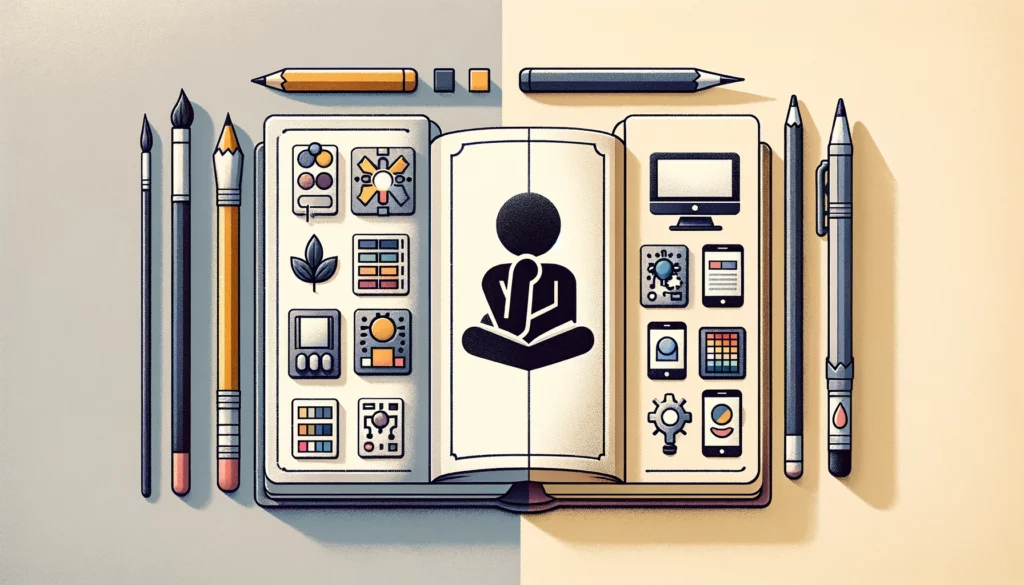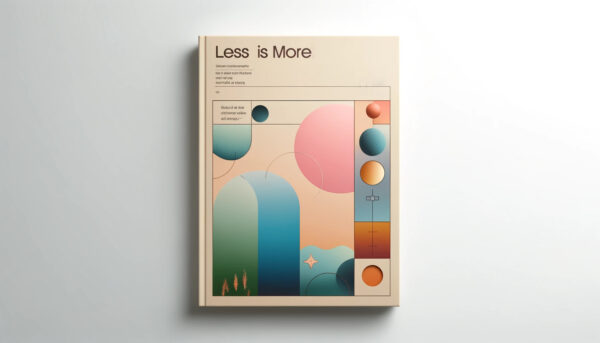
In the journey of bringing a book to life, one of the most pivotal elements is its cover. Often deemed as the first point of engagement, a book cover acts as a silent herald of the story within, making its importance in the publishing process undeniable. This initial visual encounter can captivate potential readers, making the cover not just a protective layer, but a crucial marketing tool. The adage, “Don’t judge a book by its cover,” though wise, rarely holds true in the realm of book sales, where first impressions are paramount.
The evolution of book publishing, particularly with the rise of self-publishing and independent authors, has brought new challenges and opportunities in cover design. Authors now find themselves at a crossroads: should they enlist the services of professional book cover designers, who bring expertise and an artistic eye to the table, or embrace the innovative world of Artificial Intelligence (AI) tools that promise efficiency and customization?
Hiring a book cover designer can guide you through the design process. Professional designers offer a wealth of experience and a deep understanding of what makes a cover stand out in a crowded market. They can navigate the subtle nuances of genre, audience expectations, and market trends, creating covers that not only attract attention but also resonate with the intended readership. Their skills in composition, color theory, and typography are invaluable in creating a visually appealing and thematically coherent cover.
On the flip side, the advent of AI-powered tools in cover design has opened a new frontier. These tools democratize the design process, offering an accessible and often more cost-effective route for authors. With AI, even those lacking in design expertise can explore and create covers that are both professional and personalized. This technology can also assist in refining author bios and blurbs, ensuring a cohesive presentation of the book as a whole.
However, self-published and indie authors often grapple with the decision of which path to choose. The dilemma isn’t just about aesthetics; it’s about understanding the market, identifying the target audience, and aligning the cover with the book’s essence. The decision becomes a balancing act between artistic vision, budget constraints, and marketability.
As we delve deeper into the nuances of hiring a book cover designer, we aim to navigate these challenges and present a comprehensive guide. Whether through the skilled hands of a professional designer or the innovative algorithms of AI, our goal is to help authors find the perfect fit for their book’s first impression, ensuring that the cover is not just seen, but remembered.

The Importance of Professional Designers in Book Cover Creation
In the world of publishing, creating a book cover is far more than just an exercise in aesthetic appeal; it’s a critical step in the book’s journey to its readers. The role of professional book cover designers is pivotal in this process, as they bring a unique blend of skills and expertise that can significantly influence a book’s reception and success.
Exploring the Skills and Expertise of Professional Book Cover Designers
Professional book cover designers are akin to visual storytellers. Their expertise lies not only in graphic design but also in understanding the nuances of visual communication in the context of literature. They possess a deep knowledge of typography, color theory, and imagery, allowing them to create covers that are both beautiful and meaningful. Importantly, these designers stay abreast of market trends and reader preferences, ensuring that a book’s cover is not only artistic but also relevant and appealing to contemporary audiences.
A key skill of these designers is their ability to translate an author’s vision and the book’s essence into a visual representation. This process involves a deep understanding of the book’s theme, tone, and content, which they then adeptly convert into a cover that tells a story at a glance. Their experience in the industry also allows them to navigate the technical aspects of cover design, ensuring that the final product is not only visually striking but also meets the publishing industry’s standards and specifications.
Your Publishing Journey Awaits – Start NowHow a Good Book Cover Designer Influences Book Sales and Audience Appeal
The cover of a book often serves as the deciding factor for potential readers. A well-designed cover by a professional can significantly boost a book’s visibility and appeal. It can attract the right audience, evoke curiosity, and convey the book’s genre and mood effectively. In a marketplace where readers have countless options, a standout cover can be the difference between a book being noticed or overlooked.
Professional designers understand the psychology of color, imagery, and typography and how these elements can be combined to create an emotional response in potential readers. They use this knowledge to design covers that not only grab attention but also resonate with the target audience, thereby increasing the likelihood of book sales.
The Impact of Cover Design on a Book’s Success in Its Particular Genre
Each book genre has its conventions and expectations when it comes to cover design. A professional book cover designer is adept at navigating these genre-specific nuances. For instance, a romance novel often features warm tones and intimate imagery, while a science fiction book might have a more futuristic and abstract design. Getting this genre-specific design right is crucial in attracting readers who are already interested in that particular type of book.
Moreover, a professional designer can infuse a book cover with elements that make it stand out in its genre while still adhering to genre expectations. This balance is crucial for appealing to both dedicated fans of the genre and readers who might be exploring it for the first time. Hiring a book cover designer can be an essential part of your design process.

An image demonstrating the significance of selecting the appropriate book cover designer
5 Essential Tips for Hiring A Book Cover Designer
Selecting the ideal book cover designer is a crucial decision for any author, particularly for those navigating the intricacies of self-publishing or independent publishing. This section aims to simplify this decision-making process by providing five essential tips for hiring a book cover designer who not only aligns with your vision and genre but also enhances the potential of your book to captivate and engage your target audience.
Tip 1: Assessing the Designer’s Portfolio for Quality and Relevance
When embarking on the quest to find the perfect book cover designer, the first and perhaps most crucial step is to assess the designer’s portfolio. This portfolio is a window into the designer’s style, skill, and experience. Reviewing past cover designs gives you insight into the quality of their work and their ability to capture the essence of a book’s content and theme visually.
Key to this assessment is looking for experience relevant to your book’s genre. Different genres often have different visual languages – a thriller might feature dark, intense imagery, while a romance could lean towards softer, more emotive designs. A designer experienced in your book’s genre will likely have a better grasp of these nuances, enabling them to create a cover that resonates with your target audience.
Tip 2: Understanding Your Book’s Needs and Audience
The effectiveness of a book cover largely depends on the designer’s understanding of your book’s target audience. Each book has its unique appeal, and a good designer should have the ability to tap into this, creating a cover that not just attracts but also speaks to the potential reader. During your search, engage in discussions with designers to gauge their perception of your book and its audience. Their insights can be indicative of their ability to create a cover that aligns with your book’s needs.
Tip 3: Communication Style and Work Ethic
Effective communication between you and your chosen designer is vital throughout the design process. A designer’s communication style can greatly influence the development and outcome of your book’s cover. It’s essential to assess their responsiveness, openness to feedback, and overall professionalism. A designer who actively listens, responds promptly, and is receptive to your ideas while providing expert advice is likely to be a valuable partner in the design process.
Your Publishing Journey Awaits – Start NowTip 4: Budget and Cost Effectiveness
Understanding the pricing landscape of professional book cover design is critical in making an informed decision. Prices can vary widely based on experience, expertise, and demand. It’s important to find a balance between quality and affordability. Don’t hesitate to discuss the budget upfront and seek quotations from multiple designers to get a sense of the market rate. Remember, investing in a professional and high-quality book cover can have a long-term positive impact on your book’s success.
Tip 5: Finalizing the Design
The final stage of hiring a book cover designer involves your active involvement in the selection and approval of the final design. This stage is crucial as it determines the face of your book. Be open to revisions and feedback throughout this process. A good designer will work with you to refine concepts and ideas until the final product meets your satisfaction. Remember, the cover of your book is a collaborative effort, and your input is invaluable in achieving the perfect design that captures the spirit of your book.

Exploring Spines in Book Cover Design
In the dynamic landscape of book publishing, technological advancements have introduced a groundbreaking tool: Spines’ AI-powered cover design. This AI-powered cover generator emerges as a significant player in this field, offering both an alternative and a supplementary solution to traditional book cover design.
Brief Overview of Our AI-Powered Cover Generator
Our AI-powered cover generator is a state-of-the-art tool designed to revolutionize the way book covers are created. It harnesses the power of artificial intelligence to generate cover designs that are both aesthetically pleasing and relevant to their work. This tool is particularly useful for authors who may not have the resources to hire a professional designer or for those who wish to have a more hands-on approach to the design process. Simply sign up to our platform to get started for free today.
Benefits of AI in Creating Unique and Customized Cover Designs for Authors
One of the most significant advantages of using AI in book cover design is its ability to create unique and customized covers. The AI algorithm can produce a wide range of design options, each tailored to the specific themes and elements of the book. This level of customization ensures that the cover stands out, reflecting the unique identity of the book and its author. Additionally, AI can rapidly iterate designs, providing authors with multiple options to choose from, which can be further fine-tuned to their liking.
Your Publishing Journey Awaits – Start NowAiding Authors with Specific Design Needs and Budget Constraints
For authors on a tight budget or with very specific design needs, AI can be an invaluable resource. The cost-effectiveness of an AI-powered tool makes it an attractive option for self-published authors or those just starting their publishing journey. It eliminates the need for significant upfront investment typically associated with professional cover design services. Moreover, for authors with a clear vision of their cover or specific design requirements, AI tools can offer a level of precision and customization that might be time-consuming or costly to achieve through traditional design methods.

The decision-making process involved choosing between a human designer and technological tools for book cover design
Making the Final Choice: Professional Designer or Alternative Tools?
When it comes to creating the perfect book cover, authors are often faced with a pivotal decision: should they opt for the expertise of a professional designer or explore the innovative realm of alternative tools like Spines? In this digital era, the scales are increasingly tipping in favor of AI-powered solutions, but it’s crucial to weigh the factors and make an informed decision based on your book’s specific needs.
Factors to Consider
- Budget and Cost Efficiency: One of the most compelling reasons to consider AI over a professional designer is cost efficiency. AI tools often come at a fraction of the price of hiring a professional, making them an attractive option for authors on a tight budget.
- Time Constraints: If you are working against a tight deadline, AI tools can be a lifesaver. They can generate multiple design options in a matter of minutes, a feat that can take a human designer several days or even weeks.
- Customization and Control: AI offers a high level of customization, allowing authors to have greater control over the design process. You can experiment with different styles, themes, and elements until you find the perfect fit for your book.
- Ease of Use: For those who are not tech-savvy, modern AI tools are designed with user-friendly interfaces, making them accessible to everyone, regardless of their technical skills.
Navigating the Path to Your Perfect Book Cover
In the journey of bringing a book to the marketplace, the cover stands as a critical element that bridges the creative world of the author with the expectations of the reader. This article has traversed the various aspects of choosing the right path for your book cover design, from the traditional expertise of professional designers to the innovative, cost-effective solutions offered by AI-powered tools.
The decision between a professional designer and AI should be made after carefully considering factors such as budget, time constraints, design complexity, and the level of customization required. While professional designers bring a nuanced creative touch and specialized expertise, AI tools such as Spines offer unparalleled speed, affordability, and a high degree of control over the design process.
Your Publishing Journey Awaits – Start NowAs we move forward in an increasingly digital landscape, the capabilities of AI in the realm of design are expanding, making it a viable, and often preferable, option for many authors, especially those in the self-publishing sector. The key is to identify what works best for your book’s unique narrative and audience.
Remember, the cover of your book is more than just a protective layer; it’s the first impression, the initial handshake with your potential readers, and a vital component of your book’s marketing strategy. Whether you choose the human touch of a professional designer or the efficiency and innovation of AI, the goal remains the same: to create a cover that not only encapsulates the essence of your story but also stands out on the shelves, inviting readers into the world you’ve created.







